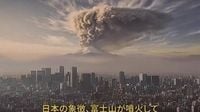On August 26, 2025, Japanese officials unveiled a striking AI-generated video simulating a violent eruption of Mount Fuji, thrusting disaster preparedness into the national spotlight and sparking fresh debate about risk, readiness, and public anxiety. The video, released to mark Volcano Disaster Prevention Day, aims to prepare the 37 million residents of the greater Tokyo metropolitan area for the worst-case scenario—one that could paralyze the world’s largest city within hours.
Mount Fuji, Japan’s iconic and tallest peak, hasn’t erupted since 1707. Yet, as the Tokyo Metropolitan Government’s video warns, an eruption could strike “at any moment, without warning.” The simulation, both haunting and hyper-realistic, opens with a woman receiving a mobile phone alert, followed by narration that cautions, “The moment may arrive without any warning,” according to News.com.au. Within hours, volcanic ash is shown shrouding central Tokyo—located about 100 kilometers (60 miles) away—turning daylight to dusk, smothering buildings and roads, and effectively halting the city’s intricate transportation networks.
The video doesn’t pull punches in its depiction of chaos. Ash blankets railway tracks and highways, rendering them impassable. Power outages cascade across neighborhoods. Phone lines go dead, isolating families and businesses. The simulation warns that volcanic ash could reach Tokyo in as little as two hours, creating immediate health risks and disrupting power, traffic, and food distribution. The government’s message is clear: “We need to arm ourselves with facts and prepare for disaster in our daily lives.” The video ends with practical advice—stock canned food and a first-aid kit, and, if venturing outside, wear masks and goggles. In March 2025, authorities had already urged residents to maintain a two-week supply of essentials, highlighting the seriousness of their approach.
Despite the urgency, officials have been careful to stress there are currently no signs of Mount Fuji erupting. “The simulation is designed to equip residents with accurate knowledge and preparedness measures they can take in case of an emergency,” the Tokyo government explained in a statement, according to AP. Mount Fuji remains an active volcano, but Japanese authorities insist there is no immediate danger. The timing of the video’s release coincides with Volcano Disaster Prevention Day, commemorating the establishment of Japan’s first volcano observatory in 1911 on Mount Asama—a reminder that Japan’s disaster planning is both deep-rooted and ever-evolving.
Japan’s meticulous approach to disaster planning is legendary. With 111 active volcanoes—out of roughly 1,500 worldwide—the country sits precariously on the Pacific “Ring of Fire,” a region notorious for seismic and volcanic activity. The nation’s vulnerability is not just theoretical. In August 2024, the Japan Meteorological Agency issued its first-ever “megaquake advisory” after a powerful earthquake struck off Kyushu. And in January 2025, the government warned there was an 80% chance of a severe earthquake hitting the southern Nankai Trough within the next 30 years. For many Japanese, the memory of being caught off guard during the 2011 Tohoku earthquake and tsunami lingers, fueling both official anxiety and public skepticism.
Not everyone has welcomed the government’s latest preparedness campaign. The AI-generated video, with its vivid imagery and dire warnings, has sown confusion and anxiety among some residents. “Are there actually any signs of eruption?” wondered Shinichiro Kariya, a 57-year-old hospital employee, as quoted by AP. “Why are we now hearing things like ‘10 centimeters of ash could fall,’ even in Tokyo? I’m wondering why this is happening all of a sudden.” Others, like Hiromi Ooki from Mishima City, have taken the warnings to heart. “Nature’s power is so great that maybe it’s better if it scares us a little,” she said, vowing to buy emergency supplies the next day.
Online, reactions have been mixed. Some users on X (formerly Twitter) expressed alarm at the prospect of “transportation chaos,” while others highlighted the practical challenges of preparing for such a disaster. “Cassette stove, flashlight, water, food,” one user listed, adding that losing power during Japan’s sweltering summer “would be hard.” Still, there are voices of criticism, with some accusing the government of stirring up a sense of crisis and fear. “It tends to be used to stir up a sense of crisis and fear,” another user commented, reflecting a broader public debate about the balance between vigilance and alarmism.
Experts are split as well. University of Tokyo professor and risk communication specialist Naoya Sekiya noted that the government has long modeled disaster scenarios, but stressed that does not mean Mount Fuji is about to erupt. “There’s no particular significance to the timing,” Sekiya told AP. Some volcanologists have gone further, calling the video “alarmist” and warning that it could scare off tourists without providing meaningful new information. The South China Morning Post cited one expert who suggested the video “reflected official anxiety about being caught off guard, as happened during the 2011 Tohoku earthquake and tsunami.”
The science of predicting volcanic eruptions, it turns out, is far from exact. According to the United States Geological Survey (USGS), earthquakes in a volcanic region can be precursors to an eruption, as was the case before Mount Fuji’s last eruption in December 1707. Seismic activity, ground deformation, heat flow, and changes in groundwater chemistry are all monitored, but eruptions can still occur with little or no warning. “Magmatic eruptions involve the rise of magma toward the surface, which normally generates detectable earthquakes,” the USGS explains. “Steam-blast eruptions, however, can occur with little or no warning as superheated water flashes to steam.”
Should Mount Fuji erupt again, the consequences could be staggering. Government estimates suggest an eruption could produce 1.7 billion cubic meters of ash, with about 490 million cubic meters potentially accumulating on roads, buildings, and other land areas. Ashfall exceeding three centimeters, especially if combined with rainfall, could cause structural collapses of weaker buildings, halt train services, block roads, and damage power lines—cutting electricity to wide swaths of the region. The potential economic loss? Up to 2.5 trillion yen, or roughly $17 billion, according to government figures reported by News.com.au.
Yet, for all the anxiety stirred by the simulation, the core message remains one of pragmatic vigilance. Japan’s history—marked by devastating earthquakes, typhoons, floods, mudslides, and volcanic eruptions—has taught its people the value of preparation. Whether the AI-generated eruption feels too close for comfort or just another chapter in Japan’s ongoing story of resilience, the country’s officials are betting that knowledge, not panic, will be its best defense.



